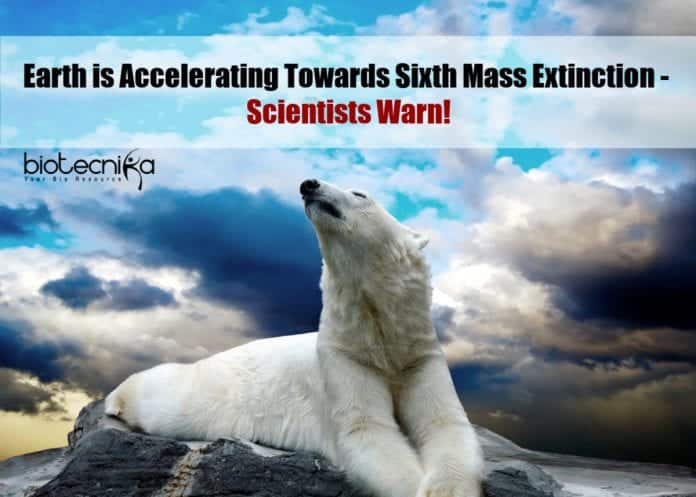Earth is Accelerating Towards Sixth Mass Extinction – Scientists Warning!
Scientists warn that the Earth is accelerating towards the sixth mass extinction event that could see the ‘disintegration of civilization’.
New research revealing the accelerating rate at which wildlife is being destroyed and the direct threat to human civilization due to this is published by the scientists who were among the first to declare the world’s sixth mass extinction event was already underway in a 2015 study.
The extinction rate is eroding nature’s ability to provide vital services to people and is likely much higher than previously thought, reported the Stanford biologist Paul Ehrlich and colleagues at other institutions in
the new paper.They stated that hundreds of species have now been wiped out and even greater numbers are pushed to the brink of extinction “at an unprecedented rate” due to the wildlife trade combined with other human impacts.
For understanding the rapid ramping-up of the scale of the disaster, the authors said that at least 543 land vertebrate species went extinct over the course of the entire twentieth century.
In the next two decades, around the same number of species are likely to go extinct, estimated Professor Ehrlich and his co-authors in this new study.
The authors warn that there could be the intensification of health threats such as we have seen with the current Covid-19 pandemic with the huge increase in extinctions and rate of wildlife destruction as it will have a disastrous impact on humans too.
Currently, the coronavirus is believed to be of animal origin originally and due to spillover infection (where a population with a high pathogen prevalence comes into contact with another potential host population), passed to humans. The reservoirs of infection are more likely to spill over into humans and other species and are more likely to grow as human activity forces wild animals into more restricted areas.
The researchers looked at the distribution and abundance of critically endangered species to gain a better understanding of the extinction crisis.
It was found that about 1.7 percent of all the species they analyzed, 515 species of terrestrial vertebrates are now on the brink of extinction, which means that the remaining number of the species is fewer than 1,000 individuals. There are fewer than 250 individuals left on the planet for about half of the species studied.
According to the researchers’ estimates, in addition to the alarming extinction rates, there have been more than 237,000 populations of those 515 species being wiped out since 1900, due to the geographic range they inhabit, localized groups of a particular species, and the cumulative loss of populations. Species are not able to perform their function in an ecosystem with fewer existing populations.
The authors said that this can have a ripple effect. For instance, the overhunting of sea otters in the 1700s was cited: the main predator of kelp-eating sea urchins were the otters. The extinction of the kelp-eating sea cow was caused directly due to the mass kelp die-offs when the sea urchin population boomed without any predators.
A senior researcher at the National Autonomous University of Mexico’s Institute of Ecology, Gerardo Ceballos, the study lead author said, “The fate of many species will be defined by what we do to deal with the current extinction crisis in the next two decades. To make sure that the numerous services nature provides us does not get irretrievably sabotaged, we are now facing our final opportunity.”
According to the researchers, there could be a domino effect on other species due to the extinction of endangered creatures. The species with populations under 1,000 live in the same areas as the vast majority (84 percent) of species with populations under 5,000. This proximity creates the conditions for a chain reaction in which other species are put at higher risk of extinction as the extinction of one species destabilizes the ecosystem.
The study says, “Extinction breeds extinction.”On the international database used to inform conservation action on a global scale, the International Union for Conservation of Nature Red List, the researchers are calling for all species with populations under 5,000 to be listed as critically endangered.
By highlighting which species and geographic regions require the most immediate attention, findings of the study could aid conservation efforts, said the team. The factors that might be most responsible for the rising extinction rates can be identified with the help of understanding which species are at risk.
They point out that due to habitat encroachment and wildlife harvesting for food, in recent decades, wild animals have transmitted many other infectious diseases to humans and domestic animals.
The president emeritus of the Missouri Botanical Garden, Peter Raven, study co-author said that, “To coming generations, what kind of a world do we want to leave – a desolate one in which the civilization we have built disintegrates rather than builds on past successes or a sustainable one? The decision is ours!”
The Proceedings of the National Academy of Sciences published this research study.
Earth is Accelerating Towards Sixth Mass Extinction, Earth is Accelerating Towards Sixth Mass Extinction






























